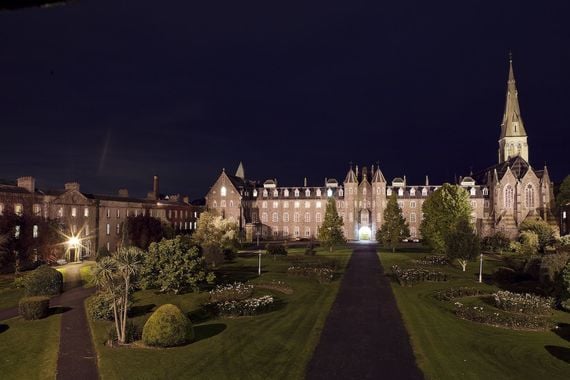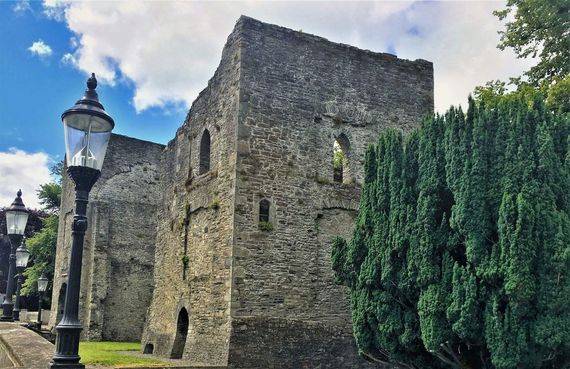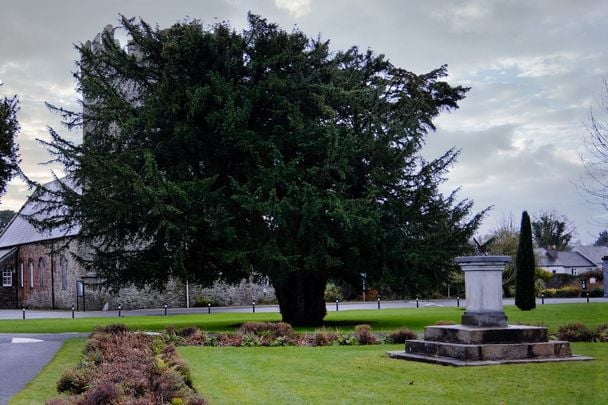It is not easy to verify which of Ireland’s many ancient trees is the oldest. However, one of the Yew trees occupying a small green just inside the entrance to Maynooth University grounds has a strong claim to the title. It is known as the Silken Thomas Yew and according to experts, the tree is about eight hundred years old.
The Silken Thomas Yew tree was planted at the time of the Crusades and has overseen the Hundred Years War, the Fall of Constantinople, the Renaissance, the Reformation, the Age of Enlightenment and the emergence of the modern era. Today, I am happy to report it is still alive and well and sits unremarkably among the landscaped gardens of the college.
Modern Maynooth is a commuter town for Dublin, ideally located as a gateway to the midlands and the West. Busy road and train routes ensure the town continues to prosper since the tree was planted all that time ago.
Support Irish Heritage Tree - plant a tree in Ireland
Maynooth is an excellent base from which to cycle the pathways of the Royal Canal or to explore the quiet rural roads of North Kildare. The surrounding area is relatively flat and fertile, good land to fatten cattle and breed horses. Not surprisingly, the area is steeped in history. Viking and Norman invaders sought out the strategic locations to build their towns and fortresses. You need not go far to find castles, townhouses and elegant estates. In medieval times, this part of Ireland was known as the Pale, a protected area where English rule prevailed, and the wild excesses of the native Irish could be kept at bay.

The South Campus at Maynooth University, County Kildare.
I’ve always had an affinity with this part of the country. People often overlook the hidden beauty and wonderful stories associated with the landmarks of North Kildare. In their rush to see the ‘real’ Ireland to the west, travelers pass all too quickly, through the ancient Ireland to the east. If they were to stop and wait a while, perhaps by an old tree, they will be amply rewarded with tales from the past and insights on the remarkable lives of the people who lived here. The Ireland we live in today was very much shaped by events that took place here long ago, in the town of Maynooth and not far from the tree.
I remember the little rhyme from my school days “In 1171, at the creek of Baginbun, Ireland was lost and won”. The reference is to the group of Norman knights landing on the beaches to the southeast. The conquest of Ireland had begun and in subsequent decades the Normans started to build their castles and occupy the eastern parts of the island. Many locals welcomed them as they provided convenient allies to help settle old feuds.
Most notably, Dermot MacMurrough enticed the Earl of Pembroke, Richard FitzGilbert de Clare, also known as Strongbow, to come to Ireland in support of his rivalry with the O’Rourkes. The O’Rourkes occupied the land to the north, what we now call County Meath, and there was a great deal of animosity between the MacMurroughs and O’Rourkes. It was a good deal for Strongbow, as well as land and a right to succession of the kingship of Leinster, he also got to marry MacMurrough’s daughter Aoife.
Support Irish Heritage Tree - plant a tree in Ireland
Not long afterward, in the thirteenth century, as the foothold of the Norman presence in Ireland grew stronger, at the confluence of two small rivers, the Rye and the Lyreen, a castle complex was established and the town of Maynooth emerged from the surroundings. At that time also, and perhaps even intended as part of the development, the small Yew sapling took root and so began the centuries-long journey of Ireland’s oldest living tree.

The Silken Thomas Yew Tree.
Norman Irish family names such as Fitzpatrick, Fitzhenry and Fitzmaurice, follow the simple format of Fitz, meaning son of, followed by a first name. Thus, the centuries-long influence of the most important family associated with Maynooth, the Fitzgeralds, is often referred to as the Geraldine Dynasty.
Fast forward three hundred years to the time of Henry VIII. Our tree is well established, perhaps even at the time described as an ‘old tree’. The castle is large and extensive with many outbuildings. The town is bustling, it is the most important town outside of Dublin. It is the height of the Geraldine Dynasty and Gerald Fitzgerald, the 9th Earl of Kildare, was Lord Deputy. In other words, he was the King of England’s representative and hence the most powerful man in Ireland.
The best way to think about English governance at the time is to imagine three zones of influence. In England, the rule of the King prevailed, this is the inner zone. Further west across the sea in Ireland, in the area encompassing North Kildare and lands north and south but not very far west we have the Pale, the buffer zone. Here Lord Deputy Fitzgerald governed on behalf of the King, it was a kind of franchise where he could leverage the brand and authority of the English monarchy but was largely free to rule as he pleased. The outer zone comprised the rest of Ireland outside the pale, basically, the Wild West, run by the local clans and chieftains.
Support Irish Heritage Tree - plant a tree in Ireland
You don’t need to be an expert in human nature to see how this can all go wrong. As the Fitzgeralds grew stronger their links with the King became more tenuous. Furthermore, as Henry became embroiled in a quarrel with the Pope over his desire to have his marriage annulled, the loyalty of the Catholic Fitzgeralds came into question. So, as a means of sorting things out, Henry calls Gerald over to London for a spell in the tower. At the time everyone knew what that meant and although Gerald decided to obey, he transferred his sword of office to his son Thomas before departing.
Thomas FitzGerald, the tenth Earl of Kildare was also known as Silken Thomas because of his flamboyant attire and the silk tassels on the uniforms of his personal guards. He could be better named as ‘calamity Thomas’ as his actions are characterized by confusion, blunder and misfortune.
The first in a series of unfortunate events began when Thomas wrongly believed a rumor that his father had been executed by the King. In a fit of rage, he gathered his army of mercenaries and rode to Dublin to throw down the sword of state thereby renouncing the King. It is said that the Bishop of Dublin tried to persuade him this was not a good idea; however, his words were misinterpreted, and Thomas became even more sure of his actions. The act was largely symbolic, and it is likely that Thomas did not want a war, he just wished to make a point and demonstrate his power. He expected local support and perhaps some leverage with the King. He was wrong!

Maynooth Castle.
It was all a bit of a mess. The King overreacted and sent an army. The other Norman barons played safe and did not support Silken Thomas. His guards betrayed him, and Maynooth Castle fell into the hands of an English army while he was in another part of the county trying to drum up support. Recognizing the precarity of his situation, he negotiated his surrender in the belief he would be well treated. He was wrong again! It is said that on the night before he turned himself in, he sat under the Yew Tree and played the lute. From that time, it was known as the Silken Thomas Yew. Unfortunately, despite the promises given to him, Thomas and his five uncles were taken to London and hanged.
You might think that would be the end of the Fitzgeralds of Kildare and indeed for a generation their lands and titles were confiscated. However, they remerge some years later, fully restored and in favor with a new king. Like the tree, they continue to grow and prosper in the plains around Maynooth. In the eighteenth century, nearby Carton House was developed as a splendid country estate and home to the Fitzgerald Dukedom of Leinster.
In 1795, the college at Maynooth was established to encourage Catholic priests to be educated in Ireland rather than Paris. The rulers at the time were concerned not to import republican ideas from the continent. The tree remained at the entrance to the new college. It is there to this day.




Comments